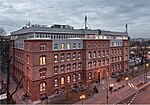The Montelupich prison, so called from the street in which it is located, the ulica Montelupich ("street of the Montelupi family"), is a historic prison in Kraków from early 20th century, which was used by the Gestapo in World War II. It is universally recognized as "one of the most terrible Nazi prisons in [occupied] Poland". The Gestapo took over the facility from the German Sicherheitspolizei at the end of March 1941. One of the Nazi officials responsible for overseeing the Montelupich Prison was Ludwig Hahn.World War II prisoners at Montelupich were made up predominantly of the ethnically Polish political prisoners and victims of the Gestapo street raids, but also German members of the SS and Security Service (SD) who had been sentenced to jail terms, British and Soviet spies and parachutists, soldiers who had deserted the Waffen-SS, and regular convicts. The number of political prisoners who passed through or ended their lives in the Montelupich in the years 1940–1944 is estimated at 50,000. Kurkiewiczowa (see Bibliography) states that "medieval tortures" constituted the fundamental and principal interrogation method of the Germans.
Although the inscription on the plaque by the (side) door of the prison in the 1939 photograph pictured at right actually reads, "Sicherheits-Polizei-Gefängnis Montelupich", the name "Montelupich Prison" is strictly informal, based on common popular convention, even if it has now passed in that form into history. The Montelupich facility was the detention centre of the first instance used by the Nazis to imprison the Polish professors from the Jagiellonian University arrested in 1939 in the so-called Sonderaktion Krakau, an operation designed to eliminate Polish intelligentsia. In January 1944, 232 prisoners from Montelupich were executed by a Nazi firing squad at Pełkinie. In late January or early February 1944, Wilhelm Koppe issued an order for the execution of 100 Montelupich prisoners as a reprisal for the unsuccessful attempt on the life of Hans Frank. In the locality called Wola Filipowska near Kraków there is a monument commemorating the execution by the Nazis of 42 hostages, all Montelupich prisoners who died on the spot before a firing squad on 23 November 1943.
After World War II, Montelupich became a Soviet prison where NKVD and Urząd Bezpieczeństwa tortured and murdered Polish soldiers of the Home Army. At present, the building serves as a temporary arrest and detention facility for men and women, with 158 jail cells and a prison hospital with additional 22 cells.









